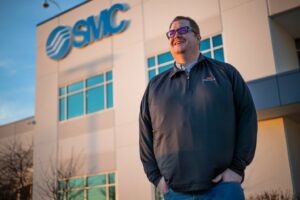Like many parents, Michael Loggins has gained a reservoir of wisdom as a father.
In his case, however, that reservoir resembles an ocean. Loggins, the global vice president of IT at SMC Corporation of America, has three children—all of whom have special needs.

Kadence, a 20-year-old college student and musician, is on the autism spectrum. Carson, 13, is on the spectrum, as well, and has dealt with a mild form of spina bifida, a birth defect in which the spine and spinal cord don’t form properly. Lastly, there’s Nolan, 17, who causes Loggins and his wife, Cheryl, “the most sleepless nights,” he says. Born with a severe form of spina bifida, Nolan has endured years of surgeries to better enable eating and other functions. He uses a wheelchair and has no feeling below his waist.
Through caring for and loving his children, Loggins has garnered a resilience and determination that has helped him in other aspects of his life, particularly in his career at SMC. “It has helped me to see and prepare for [what’s] next,” he says. “I’m not satisfied when I simply reach the next milestone.” Loggins, in short, is always looking ahead.
Applying the Personal
This philosophy is core to Loggins’ mission to drive cloud migration across all of SMC, a Tokyo-based pneumatics manufacturing company with production facilities and sales offices in more than 80 countries. SMC Corporation of America, a subsidiary based in Noblesville, Indiana, is helping lead that digital revolution from the U.S.
“SMC is 68 different organizations that have decided to start acting as one global company,” Loggins says. “The cloud is the platform we will use to reach that maturity in a fast and stable manner. We don’t have to set fire to everything that’s out there and build from scratch. With the cloud, we have the ability for everyone to get on a path to that common platform.”
“We don’t have to set fire to everything that’s out there and build from scratch. With the cloud, we have the ability for everyone to get on a path to that common platform.”
–Michael Loggins, global vice president of IT, SMC Corporation
SMC chose the Dell Technologies Cloud, powered by the latest VMware Cloud software and Dell EMC VxRail hardware. The solution enables customers to move workloads while saving time and money with full-stack integration that’s easy to deploy and manage. It also provides a path to hybrid cloud success. SMC is currently adopting a private cloud architecture, with the intent to develop a flexible and deliberate hybrid cloud strategy over the next three to five years.
“The Dell Technologies Cloud is going to be a complement as we grow,” Loggins says, adding that SMC is currently in “heavy capital expenditure mode,” though, in time, the company will focus strongly on operational expenditures. “That’s really where the Dell Technologies Cloud matches what we’re trying to do,” he says. “It gives us the ability to make that pivot.”
In fact, Loggins’ blueprint meshes with the oft-quoted mantra of Dell Technologies CEO Michael Dell: “Cloud is not a place, it is an operating model.”
For SMC, cloud adoption is also as big as the world.
Finding New Ways to Grow
Since the early 1960s, SMC operated successfully under the guidance of its 80-plus subsidiaries, which span the Americas, Europe, Africa, Asia, and Oceania. Those organizations operate with autonomy from the parent company and from their sister companies, Loggins explains.
“The thought has been—and it’s accurate—You know your market better than anyone else, so why should anyone else tell you how to manage your market?” he says.
Over the past decade, SMC executives realized that geographic borders no longer dictated corporate borders. Business increasingly went global.
“We started informally doing more work with each other [subsidiary to subsidiary],” Loggins says. “Yet it was the age-old adage: Everyone was speaking a different language. The only thing we had in common was everyone financially reported up to the parent company. In the past five years, we’ve deliberately tried to destroy those walls.”
For example, an SMC subsidiary in the U.S. might design a pneumatic system, which then would be purchased for manufacturing by a subsidiary in Singapore. That same machine would ultimately be sold by a subsidiary in South Africa.
“But we found we didn’t have the visibility we needed. We were competing against ourselves and everyone in these markets,” Loggins says. “By having a global approach with the cloud, we can now outperform our competitors and address our customers, with the same local ideas and local feel we have always had in each one of these countries. The idea is to get everyone working together.”
“But we found we didn’t have the visibility we needed. We were competing against ourselves and everyone [else]…By having a global approach with the cloud, we can now outperform our competitors and address our customers, with the same local ideas and local feel we have always had in each one of these countries. The idea is to get everyone working together.”
–Loggins
And that notion is yet another lesson drawn directly from Loggins’ life. Growing up in Indiana, he was one of nine siblings. The dynamic taught him that accomplishing big tasks was not about being a lone wolf but having a strong pack.
In high school, he participated in 4-H retreats in Indiana. His initial focus, he admits, was “a cute girl in the group.” Eventually, however, the retreats honed leadership principles in Loggins that remain in play.
“It’s always been about the family, the team, the community, whatever it is that I’m a part of. It’s about getting everyone across the finish line together,” he says. “No one shines unless we all shine.”
Over the course of his career, Indiana has bloomed into a tech hub as companies like Infosys and Salesforce opened headquarters and a wave of tech startups launched. That growth came decades after SMC Corporation of American built a factory and offices 30 minutes north of Indianapolis.
Among more than 12,000 new and retained jobs in Indianapolis since 2018, 20 percent of those workers are in the tech industry, including scientific research and computer programming, according to city tourism officials.
Despite the region’s strong base of digital manufacturing and technical schools, a “brain drain” of local talent has, nonetheless, migrated toward traditional tech hotspots like Silicon Valley, Seattle, and Boston. “This means we work very hard to not be behind the technology and process-evolution curves,” Loggins says.
It also means IT leaders there rely on Indy’s careful balance between aggressive growth and sustainable culture—along with the city’s “Midwest” pace and values—to fuel its emergence as a tech leader, he adds.
All of this aligns with Loggins’ commitment to the idea of shining together. “I can’t think of a better place to work than in Indiana,” he says. “I am surrounded with extremely intelligent, compassionate, down-to-earth people.”
Optimize infrastructure and workloads with a hybrid IT approach. Dell Technologies Cloud, powered by VMware, delivers consistent management across private, public, and edge cloud infrastructure — so you can choose the best environment for each application and use case (learn more).
Top photo: Michael Loggins, global vice president of IT at SMC Corporation of America. (Portraits by Mykal McEldowney; family photos courtesy of Michael Loggins)